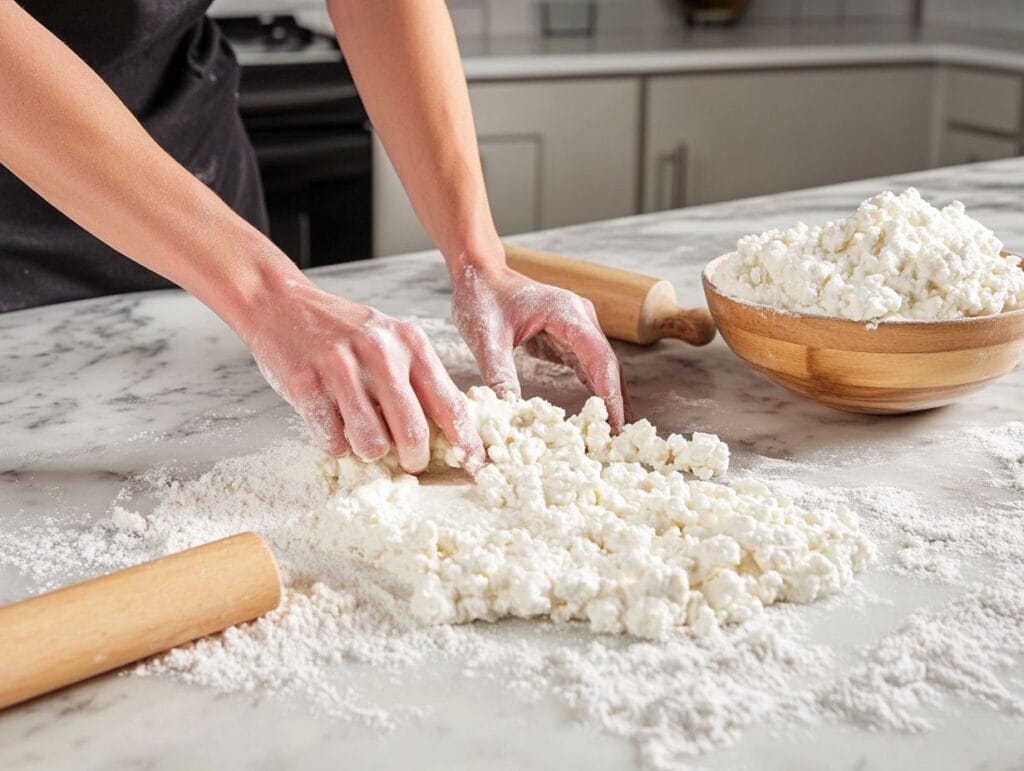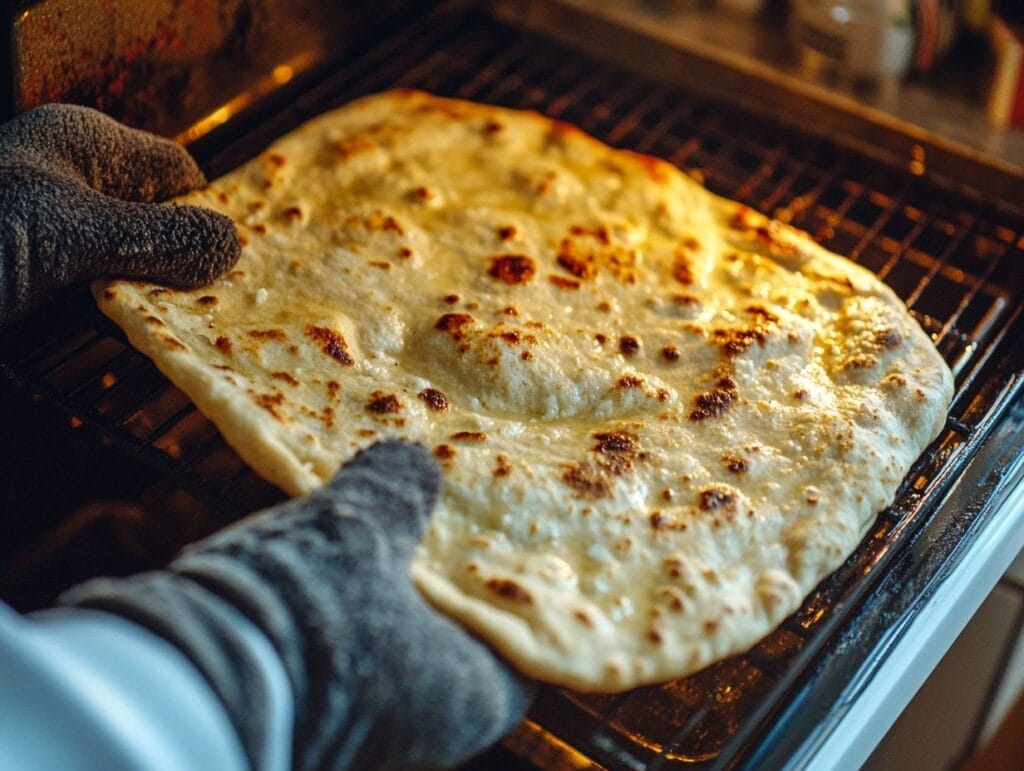Last updated on: January 15, 2025
Table of Contents
Cottage cheese flatbread, renowned for its delightful fusion of creamy texture and crisp edges, is a favorite among culinary enthusiasts. However, a common issue often mars this cherished dish: soggy cottage cheese flatbread. This unwanted sogginess can transform a delightful meal into a disappointing mess. But why does this happen? In this article, we will explore the causes of this problem and provide you with actionable solutions to ensure your cottage cheese flatbread remains perfectly crisp every time.
What is Cottage Cheese Flatbread?
Cottage cheese flatbread incorporates cottage cheese into the dough for a protein-rich base that works well with a variety of toppings. Despite its simplicity, achieving the perfect texture requires attention to moisture control and baking techniques.
For more ideas on working with cottage cheese in baking, check out Cottage Cheese Flatbread Recipes & Tips for creative variations and insights.
Why Addressing Sogginess Matters
“Nobody craves a soggy flatbread. It’s not just about taste; it’s about experiencing the joy of eating something that’s perfectly made.”
Understanding the reasons behind a soggy flatbread not only improves your cooking experience but also enhances the enjoyment for everyone who gets to taste your creations. It’s about turning what could be a simple meal into an extraordinary one!
Explore additional ways to elevate breakfast and baked goods, such as the secrets to Why Restaurant Pancakes Are So Fluffy.
Common Causes of Soggy Flatbread
Identifying the reasons behind the sogginess is the first step towards achieving that perfect crunch. Let’s break down the most common culprits:
Excess Moisture in Cottage Cheese
Cottage cheese is naturally high in moisture. While this makes for a soft, spreadable cheese, it can be problematic for flatbread, introducing too much liquid into the dough.
“The key to a crisp flatbread lies in balancing moisture. Too much, and you’re left with a soggy base.”
Incorrect Flour Type or Ratio
The type of flour you use and its proportions can greatly influence the texture of your flatbread. Using flour that’s too fine or not incorporating enough can lead to a dough that doesn’t support the moisture content properly.
Over-topping Your Flatbread
It’s tempting to load up your flatbread with all sorts of toppings, but be cautious! An excessive amount of toppings, particularly those high in water content like tomatoes or certain sauces, can weigh down the bread and trap moisture within.
Inadequate Cooking Temperature or Time
Inadequate cooking temperature or time can significantly undermine the quality of flatbread. Cooking requires a precise balance of temperature and time; if the temperature is too low or the cooking duration too short, the moisture in the dough doesn’t fully evaporate, leading to a flatbread that’s unpleasantly soggy rather than delightfully crisp. This can ruin the textural integrity and overall eating experience. Ensuring the flatbread is exposed to the correct degree of heat for the right amount of time is crucial for achieving that perfect, crisp exterior and soft, airy interior. Properly cooked, the flatbread becomes an excellent base for a variety of toppings or a standalone snack with just a touch of butter or oil.
Step-by-Step Guide to Perfect Cottage Cheese Flatbread
Achieving the perfect cottage cheese flatbread is an art, but with the right techniques, it becomes a simple process. Here’s how you can ensure a crispy, delicious outcome every time.

Choosing the Right Ingredients
Select low-moisture cottage cheese or strain your regular cottage cheese through a cheesecloth before use. Opt for high-gluten flour like bread flour that can handle more moisture and maintain structure.
Preparing Your Dough
Combine your ingredients with precision, ensuring that the moisture from the cottage cheese is well balanced with the amount of flour and any drying agents like semolina or ground oats you might choose to incorporate.
Balancing Toppings and Moisture
When topping your flatbread, think of layers rather than heaps. Spread a thin layer of sauce, if using, and choose toppings that complement rather than overpower the dough in terms of moisture.
Cooking Techniques to Prevent Sogginess
To keep cottage cheese flatbread from becoming soggy, it’s essential to focus on high-temperature cooking techniques. Baking the flatbread at a temperature above 400°F (204°C) is key, as it allows excess moisture in the dough to evaporate quickly. This process helps convert moisture to steam that escapes before it can be absorbed into the bread, resulting in a crispy crust that perfectly complements the soft, airy inside. Using high heat also prevents the bread from steaming, which can happen at lower temperatures and create a chewy, damp texture. By baking at a high temperature, you ensure a faster cook time that locks in both flavor and texture, delivering the best possible cottage cheese flatbread.

🔥 Tip: Preheat your baking surface—a baking stone or a heavy baking sheet—as you preheat your oven to ensure a super-hot surface that starts crisping the bottom of your flatbread immediately upon contact.
Stay tuned as we unravel more advanced tips and troubleshooting techniques in the next sections, ensuring your journey to the perfect cottage cheese flatbread is both enjoyable and successful. Feel free to pause here, try out these tips, and prepare for even more insights!
For more breakfast ideas, including savory options like flatbread, explore the Mini Pancake Breakfast Guide.
Advanced Tips for Expert Bakers
Taking your cottage cheese flatbread from good to great involves delving deeper into the nuances of baking science and environmental factors. You need to know here to elevate your flatbread to professional levels.
Adjusting Recipes for Humidity and Altitude
Baking isn’t just about following a recipe—it’s about adapting to your environment. Humidity can introduce unwanted moisture into your dough, while high altitudes can affect baking times and temperatures.
For those experimenting with sweet breakfast treats, try the Cinnamon Roll French Toast Recipe for inspiration.
“Always be prepared to tweak your recipes based on the day’s weather and your location. A little less water on a humid day can make all the difference.”
The Role of Resting Dough in Texture
Letting the dough rest is key to preventing soggy cottage cheese flatbread. Resting the dough before rolling it out and baking significantly improves both its texture and workability. During this time, the gluten in the flour relaxes, making the dough less elastic and easier to shape without snapping back. It also allows the moisture in the dough to distribute more evenly, creating a consistent texture throughout. This even distribution is essential for avoiding soggy spots that can occur in unevenly baked flatbread. By giving the dough time to rest, you make it easier to handle and enhance the overall eating experience, achieving a soft, tender texture that takes your flatbread to the next level.
👩🍳 Pro Tip: Let your dough rest for at least 30 minutes after mixing, or even overnight in the fridge for deeper flavor development and better texture.
Troubleshooting Common Flatbread Problems
Even with the best preparation, sometimes things don’t go as planned. Here’s how to handle common issues:
What to Do If Your Flatbread Turns Out Soggy
If your flatbread still comes out soggy despite your best efforts, consider reducing the moisture content of your toppings, or bake the base for a few minutes before adding toppings.
How to Fix Undercooked Dough
Undercooked dough is often the result of insufficient oven temperature or not enough baking time. Ensure your oven is properly preheated and consider using a pizza stone to evenly distribute heat.
Must-Try Variations of Cottage Cheese Flatbread
Once you’ve mastered the basic cottage cheese flatbread, why not experiment with some variations? Here are a few ideas to get you started:
Flavorful Toppings and Combinations
Experiment with different cheeses, fresh herbs, and spices. A sprinkle of smoked paprika or a dash of truffle oil can transform your flatbread into a gourmet experience.
Dietary Modifications: Gluten-Free and Vegan Options
To create a gluten-free version, substitute your regular flour with a high-quality gluten-free blend that includes xanthan gum to mimic the texture of gluten. If you’re looking for a vegan alternative, opt for vegan cheese and ensure that your cottage cheese substitute meets your dietary needs.
For tips on avoiding mistakes and perfecting other baked goods, read Unlocking Perfect French Toast.
The Science Behind the Perfect Flatbread
Understanding the science of what makes a flatbread perfect can help you consistently produce excellent results.
Understanding Gluten Formation
Gluten, the protein network in flour, is crucial for giving flatbread its structure and chewiness. The right amount of gluten development, through kneading and resting, is key to a perfect texture.
Moisture Control: Techniques and Tools
Using tools like a dough scraper to handle wet dough or baking on a preheated pizza stone can significantly improve the quality of your flatbread by enhancing heat distribution and moisture evaporation.
“Baking is as much a science as it is an art. The more you understand the why and how, the better your results will be.”
FAQ
Why is my flatbread doughy?
If your flatbread turns out doughy, it’s often due to underbaking or a dough that’s too moist. Make sure your oven is properly preheated and adjust the moisture content of your dough. Consider baking a bit longer to ensure it’s fully cooked.
What is the texture of cottage cheese flatbread?
Cottage cheese flatbread should have a light, airy texture with a crispy crust. The cottage cheese adds a slight creaminess to the dough, making it tender on the inside while retaining a crisp exterior when baked correctly.
Why did my cottage cheese flatbread burn?
Burning can occur if the oven temperature is too high or the flatbread is left in the oven too long. Always use an oven thermometer to check the accuracy of your oven’s settings. Also, placing the flatbread on the lowest rack can cause the bottom to burn before the rest is cooked.
Why is my cottage cheese so runny?
Runny cottage cheese might be due to the type of cottage cheese used or not draining it properly before use. Opt for a thicker, drier variety of cottage cheese, or strain it through a cheesecloth to remove excess moisture before adding it to your dough.
Conclusion
With the right techniques and a bit of practice, soggy flatbread will be a thing of the past. Embrace the process, experiment with flavors and textures, and most importantly, enjoy the delicious results of your hard work.
🌟 Remember: Each baking experience is a learning opportunity. Enjoy the journey of perfecting your cottage cheese flatbread and sharing your culinary creations with friends and family!
Summary of Key Points
In our guide to avoiding soggy cottage cheese flatbread, we’ve covered several crucial tips:
- Moisture Control: Choose low-moisture cottage cheese or strain your cheese well.
- Correct Flour Use: Use high-gluten flours like bread flour for a sturdy base.
- Proper Topping Balance: Apply toppings sparingly. Choose toppings that do not add too much moisture.
- Optimal Baking Conditions: Bake at high temperatures. Consider pre-baking the crust for crispiness.
- Environmental Adjustments: Adapt your baking approach based on humidity and altitude.
Each point is key to achieving the perfect crispy texture in your cottage cheese flatbread.
Encouragement to Experiment and Perfect Technique
Mastering perfect cottage cheese flatbread improves with practice and experimentation. Adjust the recipes to your taste and kitchen conditions. Here’s how to make each baking session a learning experience:
- Try New Variations: Experiment with different flours and topping combinations. Find what works best for you.
- Learn from Each Batch: Each oven and batch can teach you something new. Note what works and adjust.
- Share Your Experiences: Connect with other bakers. Share your challenges and successes for new insights.
“The journey to perfect flatbread is as rewarding as the results. Keep experimenting, learning, and enjoying the process!”
These practices enhance your baking skills and transform the kitchen into a playground of delicious possibilities. Happy baking!


